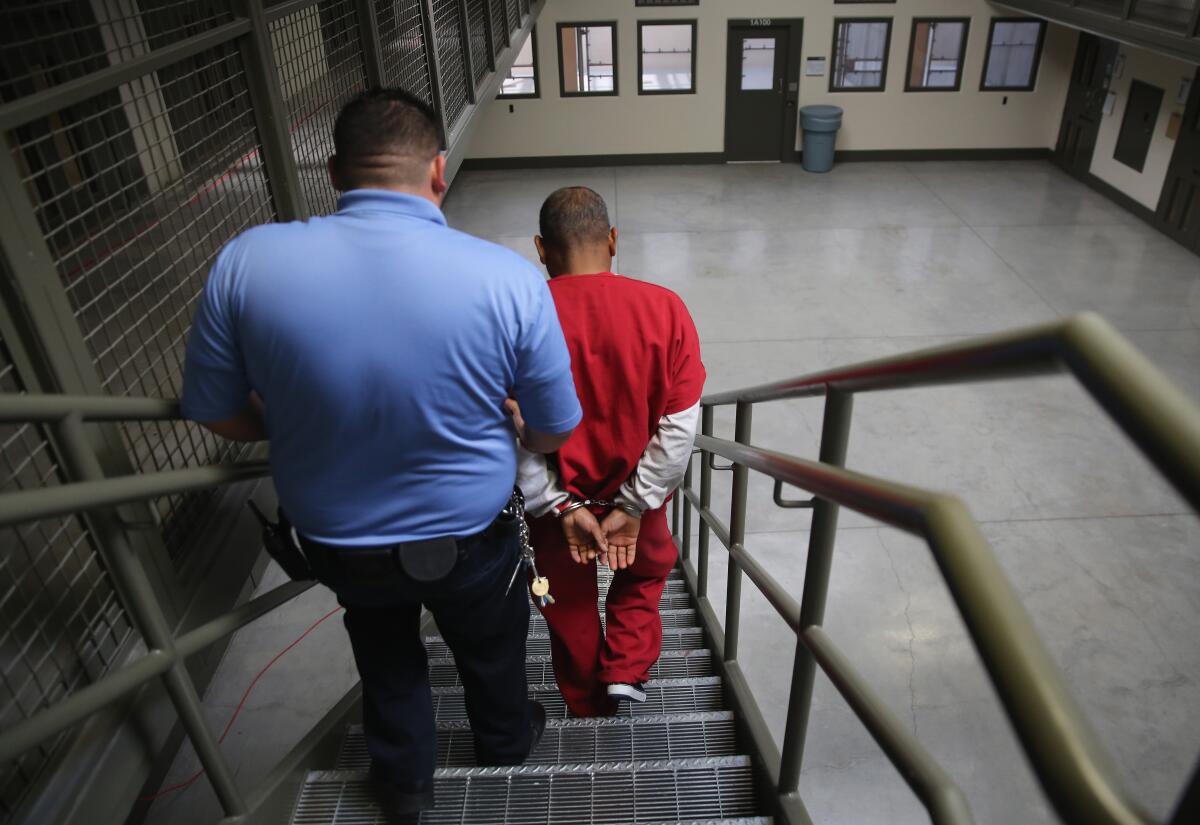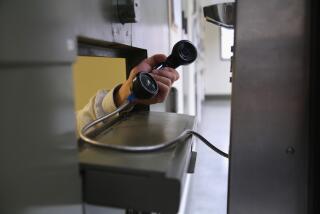Thousands of immigrants are stuck in ICE centers. Getting out depends on the judge

Belkin Peralta watched longingly May 8 as 16 women in her dormitory at the Mesa Verde ICE Processing Center in Bakersfield changed out of their blue uniforms and emerged in their street clothes. Without notice or explanation, they all had been told they were free to go.
Mesa Verde guards had told Peralta and the two other remaining women in the dorm that they would be transferred to a different facility. The 22-year-old panicked, thinking it meant she would likely be sent back to the gang violence she had escaped in Honduras.
“In my mind, we had lost, and they were going to deport us,” she said.
Instead, the next day, Peralta was taken to a nearby holding facility and released. Peralta’s cousin in Van Nuys bought her a bus ticket and picked her up at the local station that evening. She now lives with her aunt near San Diego.
Peralta’s dorm was emptied as immigration officials, under orders from a federal judge, are scrambling to create sufficient space for social distancing among detainees and staff. But her case also illustrates the inconsistent manner in which Immigration and Customs Enforcement has responded to the COVID-19 pandemic, as infections are escalating.
As of Thursday, 1,392 detainees and 44 ICE employees at detention centers had tested positive for COVID-19. The biggest outbreak by far is at Otay Mesa Detention Center in San Diego, where 158 detainees have tested positive, one of whom has died.
Nationwide, 25,900 people were detained by ICE as of May 23 — down by nearly 12,000 people since March.
In response to lawsuits and public pressure, ICE has released hundreds of immigrants from detention facilities. Others have been released after paying bond.
ICE says it has voluntarily freed more than 900 others, including Peralta and her dorm-mates, due to the pandemic. Some of the women had previously been deemed by the agency as being too dangerous to release, lawyers said.
On its website, ICE keeps a running tally of detainees who have been released under judicial order, noting that the agency is fighting many of those decisions in court.
As of Thursday, 392 detainees had been released under judges’ orders, according to the agency, 202 of them in California. ICE notes that half had been charged or convicted of crimes ranging from homicide to DUI.
“Many of the individuals ordered released by federal courts have extensive criminal histories and pose a potential public safety threat,” the website reads.
Listing off some charges of released detainees, ICE spokesman Alexx Pons said they “all align with ICE’s core mission to identify and remove those who pose a significant risk to public safety.”
“When you’re looking at custody determinations, those factors are weighed, along with an individual’s medical considerations,” Pons said.
Peralta and others said social distancing is impossible at the facilities, that detainees don’t have access to adequate hygiene supplies and that many people with COVID-19 symptoms aren’t tested. Dozens of immigrants around the state have participated in hunger strikes in recent weeks, including Peralta.
In the end, just one woman in Peralta’s dorm was deported, after being transferred to a detention facility in Louisiana. Advocates pointed to the other releases as proof that ICE exaggerates the number of detainees it claims are dangerous while ignoring the risks associated with keeping masses of people detained during a pandemic.
“They’ve always had the prosecutorial discretion to release folks immediately,” said Juan Prieto of the California Immigrant Youth Justice Alliance. “It’s a matter of challenging that notion that they should incarcerate individuals simply for being in this country without documentation.”
Prieto and other advocates scrambled to arrange temporary lodging, meals and transportation to family, or other long-term accommodations, for the women who were released unexpectedly.
Under a class-action lawsuit brought by the San Francisco Public Defender’s Office, the American Civil Liberties Union foundations of Northern and Southern California and others, 61 people have been ordered released from Mesa Verde, which has space for 400, and the Yuba County Jail, which holds up to 220 ICE detainees.
U.S. District Judge Vince Chhabria issued a searing ruling April 29, slamming ICE for failing to produce a list of detainees who are at high risk for serious outcomes if they were to contract the novel coronavirus.
Chhabria ordered ICE to provide information on every detainee at both facilities to review them for potential release on bail. At the same time, lawyers have submitted applications on behalf of dozens of people for the judge to review. So far, he has rejected 56. ICE has opposed each application up for review.
In Pennsylvania, some immigrants who were released under judicial order were later told to return to detention. Lawyers don’t expect that to happen in the case of Mesa Verde and Yuba County Jail.
But in another class-action case in California, concerning detainees at the Adelanto ICE Processing Facility near Victorville, the district judge’s far more sweeping order was overruled in the 9th Circuit Court of Appeals.
Judge Terry Hatter had ordered ICE to decrease the population at Adelanto, which currently holds about 1,200 people, to permit social distancing. He directed the agency to stop admitting new detainees to the facility and to reduce the existing population by at least 250 people by April 30.
ICE appealed the decision.
In the 9th circuit, a panel of judges reversed all but one aspect of Hatter’s ruling, maintaining that Adelanto facility administrators substantially comply with the Centers for Disease Control and Prevention guidelines for detention facilities concerning COVID-19. The reversal halted a wave of petitions for the release of immigrants held at Adelanto.
Before the 9th Circuit decision in the class-action case, Hatter had ordered the release of dozens of detainees whose lawyers filed individual petitions seeking their release.
But similar cases of immigrants who hadn’t been released are now paused.
Nicolette Glazer, an immigration lawyer in Los Angeles who represented 11 of the detainees Hatter released, said the 9th Circuit’s decision sends the message to other courts that ICE has met what’s required of it by law.
“A district court may be swayed by some of the reasoning and, regardless, ICE will be emboldened to appeal,” she said. “If we started getting more written opinions, they would become binding on district courts.”
For those who remain detained, the legal twists and turns are anxiety-inducing. In some cases, different judges have rejected or approved petitions brought by detainees with similar medical issues and legal cases.
One of those is Marco Montoya Amaya, whose request for release from Mesa Verde was denied by a federal judge in early April because the parasitic infection with which he has been diagnosed is not included in the list of conditions identified by the CDC as high-risk factors for COVID-19. Montoya, a 42-year-old from Honduras, also has latent tuberculosis.
“We are scared to die inside of here,” he said. “Every day I am ending up more traumatized.”
His lawyer Eleni Wolfe-Roubatis of the nonprofit Immigrant Legal Defense said the patchwork of releases and rejections across the country shows what advocates have long known about what she calls “the luck of the draw of the judge.”
“But when it’s life or death like this, it’s all the more stark,” she said.
On Thursday, Chhabria ordered ICE to release Montoya. He walked out of the facility that afternoon.
More to Read
Sign up for Essential California
The most important California stories and recommendations in your inbox every morning.
You may occasionally receive promotional content from the Los Angeles Times.










